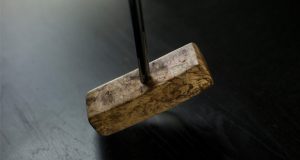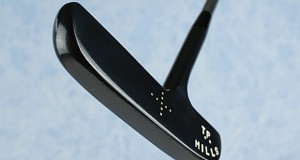PutterZone.com editor Sean Weir recently had the opportunity to visit with Duane Anderson (pictured here), the analyst who runs the putting division of TaylorMade’s Rossa MATT fitting system at the company headquarters in Carlsbad, California.
Sean wasn’t sure what to expect. What transpired was a crash course in the physics of putting, including a dissertation on an overlooked facet of putting performance: the “vertical path” of the club face at impact. Following is his personal account of what he experienced and learned in the belly of the putter fitting beast:
Duane’s putting lab is just a stone’s throw from Kia Ma’s putter workshop, but it is a world apart. Whereas Kia’s lair is abuzz with the noise of grinders and littered with metal parts, Duane’s lab is sterile and silent, a white rectangular box with a putting green, a camera, a chair and a viewing screen. A fly on the wall of this room could tell stories about the intimate putting habits of the numerous PGA and LPGA stars who have been under Duane’s microscope.
I am a “word” person, so I spend the first few minutes trying to wrap my brain around the concepts that Duane is talking about, which largely pertain to physics. Up path, transition phase, dynamic loft, frames per second, revolutions per minute…After asking Duane to repeat himself a few times, I start to put the puzzle together.
The core of Duane’s demonstration comes down to what he calls the three major factors of “launch angle and backspin rate”—putter loft, shaft lean, and vertical path (or “up” path, also known as “rise angle”). These three factors determine the launch angle and backspin rate of the putt.
Putter loft is fixed—it’s the loft built into the putter itself. Shaft lean impacts the actual, or dynamic, loft of the putter. In other words, if you have a putter with three degrees of loft and you forward press the shaft by four degrees, you have de-lofted the putter and now have a dynamic loft of minus one degree. Basic subtraction.
Into this picture comes vertical path. “Vertical path increases launch angle and decreases backspin,” Duane says.
He points to the example of Dave Stockton, who is renowned as one of the tour’s top putters and putting instructors. Stockton’s putter has five degrees of loft, and he leans his shaft forward by seven degrees, for a dynamic loft of minus two degrees. But his vertical path is 2.7 degrees, resulting in a slightly positive launch angle that gets the ball rolling quickly with effective topspin.
“You want to get the ball on top of the grass with topspin as efficiently as possible, and that’s what Stockton does,” Duane says.
To help paint a picture of the relationship between launch angle and topspin, Duane adds, “Think of tennis or ping pong. How do you hit a topspin shot? You de-loft the racket and hit the ball from underneath. You have negative loft, but you are hitting on the upstroke. That’s Stockton.”
Vertical path, however, is often overlooked or misunderstood. Duane points to a Golf Digest article in which several top instructors were asked their thoughts on angle of attack (ie: vertical path), and the answers were all over the map, with few suggesting actually striking the ball on the upstroke.
So what does this mean for the average recreational golfer? It’s hard to say, as each individual is different. If you have a negative dynamic loft and a vertical path of zero at impact, you are going to drive the ball into the ground and generate a bounce.
But if you move the ball forward in your stance to increase the vertical path, you might open the door to alignment problems. So you need to be careful when you tinker with your putter, mechanics or setup, as you don’t want to trade one problem for another. Duane cautions that we are talking about a complex series of movements, and they are all related to one another. Getting properly fit for a putter—including loft—is a good place to start.
There are other factors as well, such as the speed of the greens you normally play. Duane says that tour professionals can get away with a lower launch angle because the grass is so short and tight on tournament courses. The rest of us will likely benefit from a higher launch angle to get the ball on top of the grass as efficiently as possible.
The goal, he says, is to shorten the “transition phase” as much as possible. The transition phase is the space between when the ball is struck and when it achieves true roll with effective topspin. The transition phase takes place in the first 10 to 20 percent of the putt’s distance.
When the transition phase is reduced, you minimize the potential impact of imperfections in the green—such as spike marks, divots, soft spots, debris, etc.—that can knock the ball off track. If the ball is launched too high, or if you drive it into the grass, you will extend the transition phase. Hence, the importance of a healthy and consistent launch angle.
I leave Duane’s lab with my head spinning, enlightened by his insights and anxious to observe them in my own game, and to ultimately apply them as well. Easier said than done, of course, but who said golf was easy?
P.S. While Duane’s lair is reserved for TaylorMade’s tour staff professionals, you can experience the same proprietary MATT analysis technology at one of TaylorMade’s Performance Labs. Click here for PutterZone.com’s review of the TaylorMade Performance Lab experience.
 PutterZone – Best Putter Reviews
PutterZone – Best Putter Reviews




Dear Sean,
The idea of Duane that the objective of the stroke is to reduce the "transition zone" is not correct. Any putt will "get good" in as little as the first 2-3 inches on the ground, and thereafter in the remainder of the putt's length, what was initially a "bad" backspin starts is NO DIFFERENT than a "good" forward spin putt. It's physics and it's in all the high speed photos at TaylorMade. And in the TaylorMade YouTube interview with Dave Stockton about this, Dave commented that his forward rolling "really made the ball roll out" for superior distance control; but the TaylorMade data guy responded, "Not really. Forward roll might help prevent dispersion of the line left or right, but has very little effect on distance." And also the suggestion that rolling a ball MUST use negative loft with a slight upswing is also incorrect. the real physics of rolling a ball does not require that combination, and certain combinations of a positive loft with slight upswing thru impact do a great job of rolling the ball also.
As Geoff mentions once the ball is on the ground it quickly converts to forward roll, no question.
We've found with the SAM PuttLab an easy way to speak to forward roll profiles.
Simply stated limited loft and rise create forward roll from impact. But don't be confused with rise being manufactured by you the golfer. It is a product of the vertical nature of the putting stroke.
Sean, that was a great read. Possibly a bit over this pea brain of mine, but worthy of some GreenSide experimentation. I keep wondering how all of this could be effected by inserts or special milling, but the basic seems to comes down to getting the ball on top quickly and topspin.